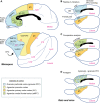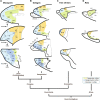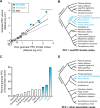Evolution of prefrontal cortex
- PMID: 34363014
- PMCID: PMC8617185
- DOI: 10.1038/s41386-021-01076-5
Evolution of prefrontal cortex
Abstract
Subdivisions of the prefrontal cortex (PFC) evolved at different times. Agranular parts of the PFC emerged in early mammals, and rodents, primates, and other modern mammals share them by inheritance. These are limbic areas and include the agranular orbital cortex and agranular medial frontal cortex (areas 24, 32, and 25). Rodent research provides valuable insights into the structure, functions, and development of these shared areas, but it contributes less to parts of the PFC that are specific to primates, namely, the granular, isocortical PFC that dominates the frontal lobe in humans. The first granular PFC areas evolved either in early primates or in the last common ancestor of primates and tree shrews. Additional granular PFC areas emerged in the primate stem lineage, as represented by modern strepsirrhines. Other granular PFC areas evolved in simians, the group that includes apes, humans, and monkeys. In general, PFC accreted new areas along a roughly posterior to anterior trajectory during primate evolution. A major expansion of the granular PFC occurred in humans in concert with other association areas, with modifications of corticocortical connectivity and gene expression, although current evidence does not support the addition of a large number of new, human-specific PFC areas.
© 2021. The Author(s), under exclusive licence to American College of Neuropsychopharmacology.
Conflict of interest statement
The authors declare no competing interests.
Figures





Similar articles
-
The evolution of brains from early mammals to humans.Wiley Interdiscip Rev Cogn Sci. 2013 Jan;4(1):33-45. doi: 10.1002/wcs.1206. Epub 2012 Nov 8. Wiley Interdiscip Rev Cogn Sci. 2013. PMID: 23529256 Free PMC article. Review.
-
Topographical organization of the cortical afferent connections of the prefrontal cortex in the cat.J Comp Neurol. 1985 Dec 15;242(3):293-324. doi: 10.1002/cne.902420302. J Comp Neurol. 1985. PMID: 2418073
-
Cyto-, myelo- and chemoarchitecture of the prefrontal cortex of the Cebus monkey.BMC Neurosci. 2011 Jan 13;12:6. doi: 10.1186/1471-2202-12-6. BMC Neurosci. 2011. PMID: 21232115 Free PMC article.
-
Orbitomedial prefrontal cortical projections to distinct longitudinal columns of the periaqueductal gray in the rat.J Comp Neurol. 2000 Jul 10;422(4):556-78. doi: 10.1002/1096-9861(20000710)422:4<556::aid-cne6>3.0.co;2-u. J Comp Neurol. 2000. PMID: 10861526
-
Agranular frontal cortical microcircuit underlying cognitive control in macaques.Front Neural Circuits. 2024 Mar 27;18:1389110. doi: 10.3389/fncir.2024.1389110. eCollection 2024. Front Neural Circuits. 2024. PMID: 38601266 Free PMC article. Review.
Cited by
-
Secretagogin as a marker to distinguish between different neuron types in human frontal and temporal cortex.Front Neuroanat. 2023 Nov 1;17:1210502. doi: 10.3389/fnana.2023.1210502. eCollection 2023. Front Neuroanat. 2023. PMID: 38020216 Free PMC article.
-
Adolescent sleep and the foundations of prefrontal cortical development and dysfunction.Prog Neurobiol. 2022 Nov;218:102338. doi: 10.1016/j.pneurobio.2022.102338. Epub 2022 Aug 11. Prog Neurobiol. 2022. PMID: 35963360 Free PMC article. Review.
-
Comparative transcriptomic rhythms in the mouse and human prefrontal cortex.bioRxiv [Preprint]. 2024 Sep 26:2024.09.26.615154. doi: 10.1101/2024.09.26.615154. bioRxiv. 2024. Update in: Front Neurosci. 2025 Jan 13;18:1524615. doi: 10.3389/fnins.2024.1524615. PMID: 39386590 Free PMC article. Updated. Preprint.
-
The prefrontal cortex: from monkey to man.Brain. 2024 Mar 1;147(3):794-815. doi: 10.1093/brain/awad389. Brain. 2024. PMID: 37972282 Free PMC article. Review.
-
The role of prefrontal cortex in cognitive control and executive function.Neuropsychopharmacology. 2022 Jan;47(1):72-89. doi: 10.1038/s41386-021-01132-0. Epub 2021 Aug 18. Neuropsychopharmacology. 2022. PMID: 34408280 Free PMC article. Review.
References
-
- Bolker J. Model organisms: there’s more to life than rats and flies. Nature. 2012;491:31–3. - PubMed
-
- Logan CA. The altered rationale for the choice of a standard animal in experimental psychology: Henry H. Donaldson, Adolf Meyer and ‘the’ albino rat. Hist Psychol. 1999;2:3–24. - PubMed
-
- Murray EA, Wise SP, Graham KS. The evolution of memory systems: ancestors, anatomy, and adaptations. Oxford, UK: Oxford University Press; 2017.
-
- Preuss TM. The discovery of cerebral diversity: an unwelcome scientific revolution. In: Falk D, Gibson KR, editors. Evolutionary anatomy of the primate cerebral cortex. Cambridge, UK: Cambridge University Press; 2001. p. 138–64.
Publication types
MeSH terms
Grants and funding
LinkOut - more resources
Full Text Sources
Other Literature Sources
Miscellaneous

